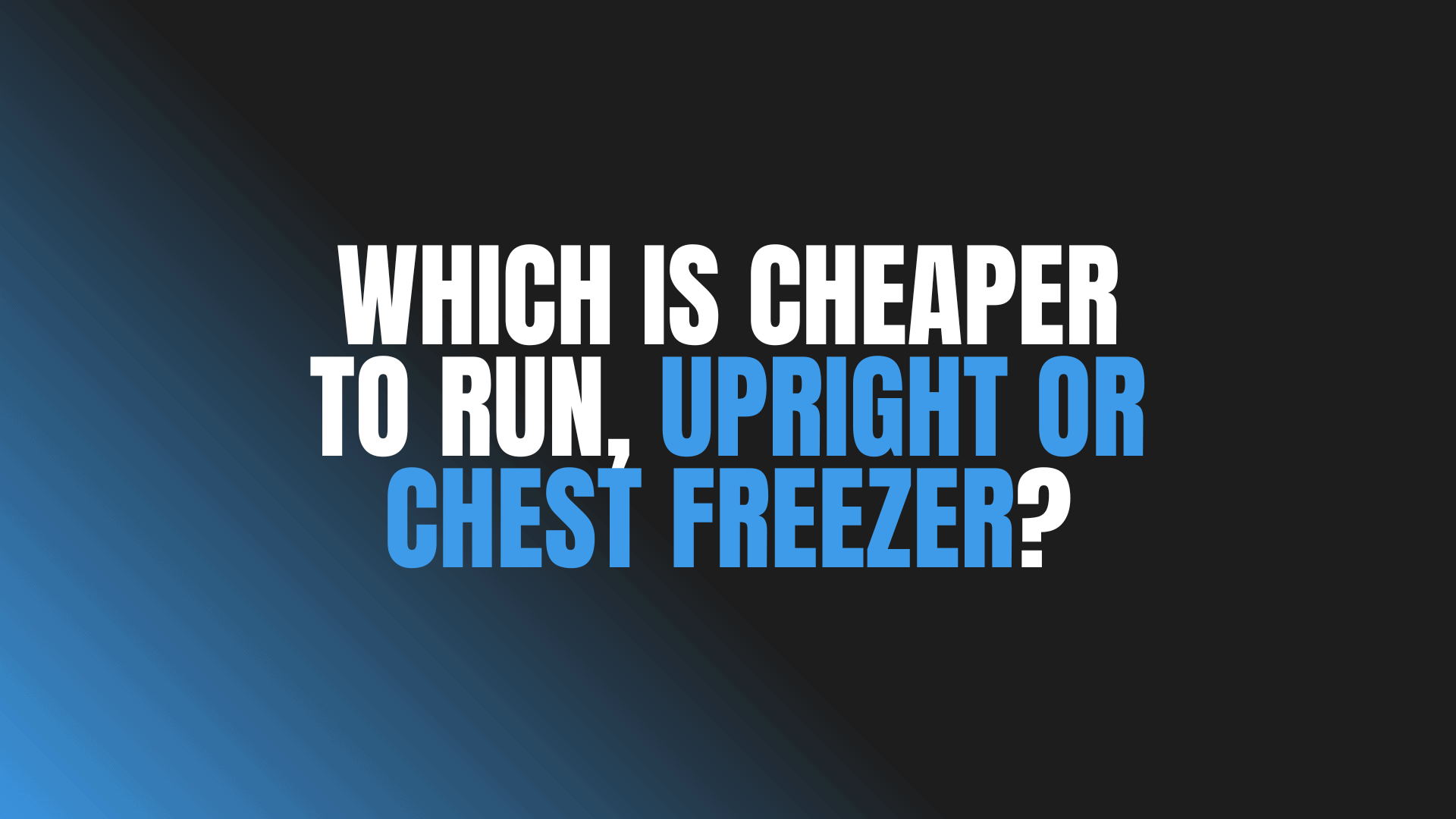
Question: Which Is Cheaper to Run, Upright or Chest Freezer?
Answer: Chest freezers are typically cheaper to run. Their design retains cold air more effectively when the lid is opened, as cold air is dense and sinks. This leads to greater energy efficiency and lower electricity bills compared to upright models of a similar size.
Comparing the Running Costs of Upright and Chest Freezers
Choosing a new freezer involves more than just considering the purchase price. The long-term running cost is a significant factor that impacts your household budget. Homeowners often ask which is cheaper to run, an upright or a chest freezer. The answer directly relates to how each appliance is designed and how it uses energy to keep your food frozen. Understanding these differences helps you make an informed financial decision for your home.
This comparison explores the key elements that determine freezer energy consumption. We will examine the fundamental design of both chest and upright models. We will also analyze features like auto-defrost and ENERGY STAR ratings. By looking at these factors, you can accurately predict which type of freezer will be more economical over its lifespan. The choice depends on your usage habits, storage needs, and household budget, but one model generally holds a clear advantage in energy efficiency.
The lower electricity bill often comes from the appliance that works smarter, not harder. We will break down why one design retains cold air more effectively, leading to lower energy usage. This analysis will provide the clear, practical information you need to select a freezer that saves you money every month while reliably preserving your food.
How Chest Freezer Design Promotes Energy Efficiency
Chest freezers are generally more energy-efficient than their upright counterparts. This efficiency stems directly from their fundamental design and the laws of physics. A chest freezer opens from the top. Cold air is denser than warm air, so it naturally sinks and settles at the bottom. When you lift the lid of a chest freezer, most of the heavy, cold air remains inside the insulated box. This simple fact means the compressor does not need to work as hard to re-cool the interior after the lid is closed.
The construction of a chest freezer also contributes to its low running costs. The walls are typically better insulated than those of an upright model. This extra insulation minimizes temperature leakage, keeping the cold in and the ambient room heat out. The seal on a chest freezer’s lid is also very effective. Gravity helps pull the lid down, creating a tight seal that prevents cold air from escaping and warm air from entering. This robust seal reduces the frequency at which the cooling system must activate, saving a considerable amount of energy over time.
Another factor is the defrosting method. Most chest freezers require manual defrosting. While this is a periodic chore, it means the freezer does not have an internal heating element that cycles on to melt ice buildup. These auto-defrost cycles on upright freezers consume extra electricity. The absence of this feature makes the chest freezer’s operation simpler and more cost-effective.
Click here for more information on cupboard refacing Toronto
Related Article: Is a Deep Freezer Just a Chest Freezer?
Features That Impact Your Electricity Bill
When you compare freezers, specific features have a direct impact on how much electricity they use. Understanding these features helps you decide which is cheaper to run, an upright or a chest freezer. The most important distinction is between manual defrost and auto-defrost models.
-
Auto-Defrost Systems
Found primarily in upright freezers, this feature provides convenience by preventing ice buildup. It works by using a heating element to periodically melt frost. This process consumes significant energy, making frost-free models more expensive to operate than manual defrost units. The cycle of heating and re-cooling adds a consistent load to your electricity bill.
-
Manual Defrost Systems
Common in chest freezers, manual defrost models require you to periodically turn off the unit to melt ice. Because they lack an internal heater, they use much less energy. If you can manage the occasional inconvenience of defrosting, a manual defrost freezer offers substantial long-term savings on running costs.
-
ENERGY STAR Certification
Always look for the ENERGY STAR label. Certified freezers must meet strict energy efficiency guidelines set by the government. An ENERGY STAR chest freezer is typically at least 10% more efficient than a non-qualified model. An ENERGY STAR upright freezer also offers savings, though it will still generally use more energy than a comparable chest freezer.
Calculating the Real-World Cost Difference
To determine the actual cost of running a freezer, you need to look at its energy consumption rating. This information is usually found on the EnerGuide label required on appliances in Canada. The label provides an estimated annual energy consumption in kilowatt-hours (kWh). A lower kWh number means the appliance is more efficient and will be cheaper to run. Chest freezers consistently have lower annual kWh ratings than upright freezers of the same size and capacity.
You can calculate the annual running cost with a simple formula. First, find the freezer’s annual kWh consumption on its EnerGuide label. Next, find the price you pay for electricity per kWh from your utility bill. The cost can vary by province and time of day. Multiply the freezer’s annual kWh rating by your electricity rate to get the estimated yearly cost. For example, a freezer using 300 kWh per year with an electricity rate of $0.15 per kWh would cost $45 per year to operate (300 kWh x $0.15/kWh).
When you apply this calculation, the difference becomes clear. A modern 15-cubic-foot chest freezer might use around 250 kWh annually, costing approximately $37.50 per year at a $0.15/kWh rate. In contrast, a 15-cubic-foot upright freezer with auto-defrost might use 400 kWh or more, costing $60 per year. Over a freezer’s typical 15-year lifespan, this difference adds up to over $330 in savings, making the chest freezer the clear winner for lower running costs.
Costs Beyond the Electricity Bill
While running costs are a primary concern, other financial factors influence the total cost of ownership. The initial purchase price is the first expense you will encounter. Generally, chest freezers are less expensive to buy than upright freezers of a similar volume. The simpler design and manufacturing process of a chest freezer often translate to a lower price tag, giving it an immediate cost advantage.
Maintenance and longevity also play a role. Chest freezers have a simpler cooling system with fewer components that can fail. The lack of an auto-defrost system or complex shelving means there are fewer parts to repair or replace. This simplicity often leads to a longer lifespan with fewer maintenance issues. Upright freezers, with their fans and automatic defrost heaters, introduce more potential points of failure, which could lead to repair costs down the road.
Finally, consider the potential cost of food spoilage during a power outage. Because of their superior insulation and design that traps cold air, chest freezers can keep food frozen for a much longer period without power. A well-stocked chest freezer can stay frozen for two to three days, while an upright freezer may only last for about a day. This resilience can save you hundreds of dollars in lost food during an extended outage, making the chest freezer a more secure and ultimately more economical investment.
Conclusion
After comparing all the factors, the evidence is clear: a chest freezer is cheaper to run than an upright freezer. Its design naturally conserves cold air, its insulation is often superior, and the common manual-defrost system avoids the energy-intensive cycles of frost-free models. These efficiencies translate directly into lower monthly electricity bills. If your primary goal is to minimize long-term operational expenses, the chest freezer is the superior choice. The initial purchase price is also typically lower, providing an immediate saving that continues over the appliance’s life.
However, the total value of a freezer is not measured in running costs alone. You must also consider convenience and space. Upright freezers offer better organization with shelves and bins, making it easy to see and access your food. This accessibility can reduce food waste because items are less likely to get buried and forgotten. Upright models also have a smaller floor footprint, making them a better fit for kitchens or utility rooms with limited space. For many households, these practical benefits can outweigh the higher energy costs.
Your final decision on which is cheaper to run, an upright or chest freezer, must balance cost with usability. Assess your budget, available space, and how you plan to use the freezer. If you have ample space in a garage or basement and want the lowest possible running cost, a chest freezer is the best option. If you need easy access to organized items and have limited floor space, the slightly higher running cost of an upright freezer may be a worthwhile trade-off for its everyday convenience.

Blue Malue Get in touch with Blue here.
